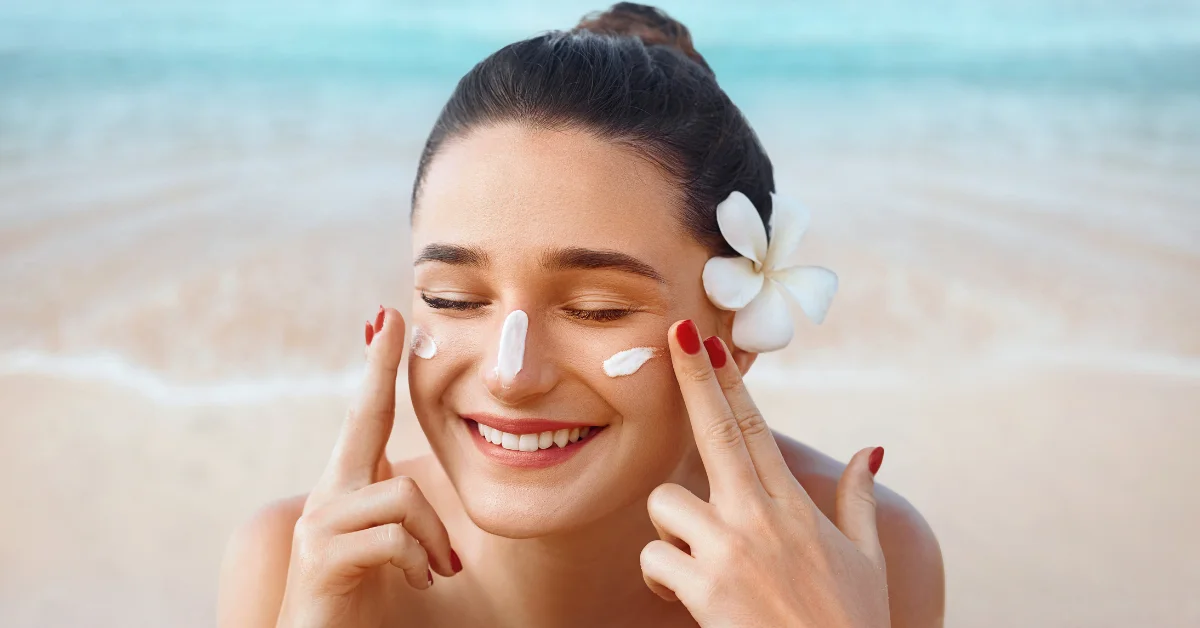Sunscreen is one of the most important skincare products, especially when it comes to protecting our faces from sun damage. However, do you know how much sunscreen you should be using on your face?
Many people are unsure about the right amount to apply, which can lead to inadequate protection against harmful UV rays.
Welcome to our guide on “How Much Sunscreen to Use on Your Face: The Right Amount,” where we unravel the mysteries of sun protection, explore the significance of SPF ratings, and reveal expert tips for achieving optimal facial sun safety.
Why Is Using Sunscreen on Your Face Important?
The skin on our face is more delicate and sensitive compared to the rest of our body. It is also constantly exposed to the sun’s rays, making it more susceptible to damage and premature skin aging.
UV radiation can cause various skin issues, such as sunburns, wrinkles, dark spots, and even cancer. Therefore, using sunscreen on your face is crucial in protecting it from these harmful effects.
Moreover, sun protection is essential regardless of your skin tone or type. Contrary to popular belief, people with darker complexions are not immune to the damaging effects of UV rays and need sunscreen just as much as those with lighter skin tones.
The Crucial Role of Sunscreen in Facial Skin Protection
Applying sunscreen on your face every day is an essential step in any skincare routine. It not only protects your skin from sun damage, but it also helps maintain a youthful appearance by preventing premature skin aging.
The sun’s UV rays break down the collagen fibers in our skin, causing sagging and wrinkles over time. By using sunscreen regularly, we can slow down this process and keep our skin looking healthy and vibrant.
Additionally, using sunscreen can also help prevent the development of skin cancer. According to the Skin Cancer Foundation, daily use of at least SPF 15 or higher sunscreen can reduce the risk of developing melanoma by 50%.
This statistic alone highlights how crucial it is to incorporate sun protection into our daily routine.
Moreover, using sunscreen on your face can also prevent various other skin issues such as dark spots, hyperpigmentation, and uneven skin tone.
These concerns are often caused by sun and UV exposure, and consistent use of sunscreen can effectively prevent them from appearing.
SPF: What It Means and Why It Matters
SPF is a crucial attribute in choosing the right facial sunscreen. This figure represents the level of protection that a sunscreen can provide against the harmful UVB rays of the sun.
UVB rays are primarily responsible for visible changes on the skin’s surface, such as sunburns and tanning, and can contribute to skin cancer.
Applying a facial sunscreen with an appropriate SPF can shield your skin from these detrimental effects. For instance, an SPF of 30 protects against approximately 97% of UVB rays, while an SPF of 50 protects against around 98%.
These percentages might seem close, but the difference can have a substantial impact on your skin’s health, particularly if you have fair or sensitive skin.
It’s worth noting that while higher SPF offers more protection, no sunscreen can block 100% of UVB rays. Therefore, it’s essential to reapply sunscreen every two hours and immediately after swimming or sweating for maximum protection.
Furthermore, using other forms of sun protection like hats and sunglasses, and seeking shade during peak hours of sun intensity, can significantly boost your defense against harmful UV exposure.
So, what exactly does SPF 30 mean? It means that you can stay in the sun thirty times longer than if you were not wearing any sunscreen without getting sunburned.
However, this is just an estimated figure as there are many other factors at play, such as skin type, amount of sunscreen applied, and time spent in direct sunlight.
Therefore, it’s crucial to always follow the application instructions on your sunscreen product and adjust accordingly based on your skin type and sun and UV exposure.
In summary, SPF is a measure of how well a sunscreen can protect your skin from UVB. It’s crucial to choose a facial sunscreen with an appropriate SPF based on your skin type and the intensity of sun and UV exposure.
How Much SPF Do You Need for Face?
The amount of sunscreen you need for your face is approximately a nickel-sized dollop as per the American Academy of Dermatology Association. This should be enough to adequately cover all exposed areas of your face without leaving any parts unprotected.
It’s important to apply sunscreen to all regions of your face, including easy-to-miss areas like the underside of your chin, your hairline, and the tops of your ears. For your neck and the back of your hands, which are also exposed to the sun, an additional dollop of sunscreen is recommended.
Remember, sunscreen should be reapplied every two hours, and immediately after sweating, swimming, or towel drying. It’s essential to use enough product and apply it properly to ensure you’re getting the full SPF value and protection from your sunscreen.
Key Areas of Your Face That Demand Sunscreen Protection
The bridge of your nose, cheekbones, and forehead are areas of your face that are particularly susceptible to sun damage because they protrude slightly and therefore catch more rays. The skin around your eyes, including the lids, is very thin and sensitive, making it vulnerable to burns and skin cancers.
Your lips, like your eyes, also have thinner skin and can easily burn, so a lip balm with SPF is a must. The tips of your ears are often forgotten but are a common location for skin cancer due to sun exposure. Make sure to cover these key areas thoroughly with sunscreen to prevent long-term damage.
SPF Levels: Understanding the Numbers
SPF stands for Sun Protection Factor and is a measure of how much UVB (ultraviolet B) radiation a sunscreen can protect against.
The higher the SPF number, the longer the protection lasts. For example, an SPF 30 sunscreen will block about 97% of UVB rays, while an SPF 50 sunscreen will block about 98% of UVB rays. It’s important to note that SPF only measures protection against UVB rays, not UVA (ultraviolet A) rays, which can also cause skin damage and aging.
That’s why it’s essential to choose a sunscreen that is labeled “broad-spectrum,” meaning it protects against both types of UV rays.
Reapplying Sunscreen Over Makeup: A Step-by-Step Guide
For those who wear makeup, reapplying sunscreen throughout the day can be a challenge. However, it is possible to protect your skin without messing up your makeup. Here’s how:
- Blot your face with a tissue or blotting paper to remove excess oil and sweat.
- Use a powder sunscreen, which can easily be applied over makeup without smudging or ruining your look.
- Apply the powder sunscreen with a brush, focusing on areas that tend to get the most sun exposure, such as the forehead, nose, and cheeks.
- If you prefer a liquid sunscreen, use a makeup sponge to gently dab it onto your face without disturbing your makeup.
- Don’t forget to apply sunscreen to areas like your neck, ears, and hands, which are often neglected but still need protection.
- Use a setting spray or powder to help keep your makeup in place and provide extra sun protection.
- Try to reapply sunscreen every two hours if you will be spending extended periods of time in the sun.
Types of Sunscreen for Your Face
When it comes to choosing a facial sunscreen, there are two main types: physical sunscreen and chemical sunscreen.
Physical sunscreens contain mineral sunscreen ingredients such as zinc or titanium dioxide that act as a physical barrier to reflect UV protection.
Chemical sunscreens, on the other hand, contain organic compounds that absorb UV radiation and convert it into heat.
Both types of sunscreen can offer excellent protection, but it’s essential to choose one that works best for your skin type and concerns. For example, physical sunscreen are typically better for sensitive skin, while chemical sunscreens may be preferred by those with oily or acne-prone skin.
It’s always a good idea to test out different products before committing to one.
Moisturizer vs. Sunscreen: Which Is Better for Your Face?
When it comes to the debate between moisturizers and sunscreen, both products play vital and distinct roles in skincare routine. Moisturizers hydrate the skin, replenish its natural barrier, and help maintain its overall health, reducing the appearance of lines and wrinkles.
On the other hand, sunscreen protects the skin from harmful ultraviolet (UV) radiation, preventing sun damage, skin cancer, and premature aging. While some moisturizers contain SPF, they typically do not offer enough protection on their own, and should not replace sunscreen in your routine.
Therefore, rather than choosing one over the other, it’s imperative to use both daily. Apply a moisturizer first to hydrate your skin, and follow it up with a broad-spectrum sunscreen to ensure maximum protection.
Remember to reapply sunscreen every two hours, or after sweating or swimming. Additionally, it’s essential to choose the right products for your skin type and concerns. If you have dry skin, opt for a rich moisturizer, while those with oily or acne-prone skin may benefit from lightweight and oil-free sunscreen formulations.
Experiment with different products and don’t be afraid to ask for recommendations from skin care professionals to determine what works best for you.
With consistent use, these two products can work together to achieve your desired skin goals and maintain its overall wellness. So don’t forget to moisturize and protect your skin every day for a healthy and glowing complexion.
Conclusion
In conclusion, the path to achieving the right amount of sunscreen for your face is not just about the product you choose but also about understanding your skin’s unique needs and being mindful of the environmental factors at play.
By selecting the appropriate sunscreen for your skin type and considering the various product forms available, you empower yourself to defend against the sun’s relentless impact.
Remember, this seemingly small step can make a significant difference in preserving your skin’s health, youthfulness, and radiance. So, take care, be sun-smart, and enjoy the sun while staying beautifully protected.
FAQ's
Is SPF 30 or 50 better for face?
The choice between SPF 30 and 50 depends on your sun exposure and skin type. SPF 50 offers slightly higher protection and is preferable for extended sun exposure.
Is SPF 50 too much for face?
SPF 50 is not too much for the face; it provides excellent protection, especially in high sun-intensity situations..
How much SPF should I use on my face?
Generally, using an SPF of 30 or higher is recommended for your face, but the specific SPF you should use may vary based on your skin type, the sun’s intensity, and the duration of sun exposure.
Is SPF 100 too much for face?
SPF 100 may be excessive for most people’s daily needs, as it offers only a marginal increase in protection over SPF 50. For everyday use, SPF 30-50 is often sufficient.


